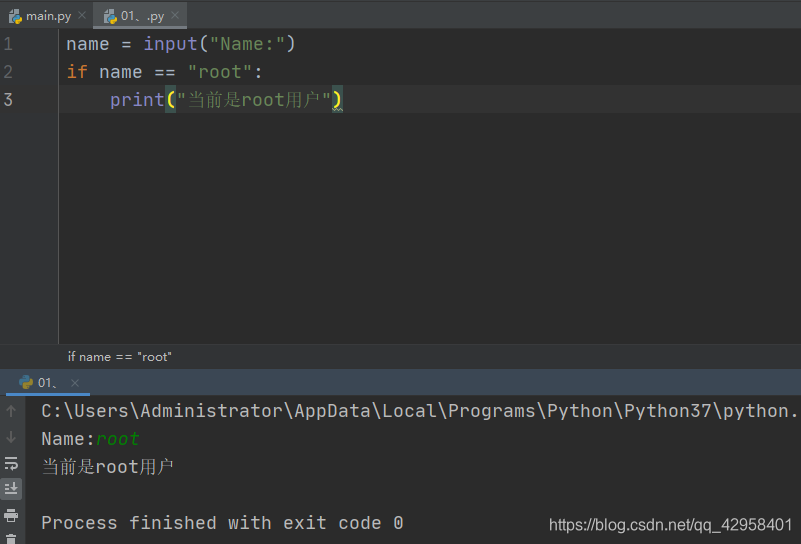
1. Single branch statement (with only one condition)
#判断当前用户是否为root
name = input("Name:")
if name == "root":
print("当前是root用户")

2. Double-branch statement (execute output separately for a condition that is satisfied or not satisfied)
#判断输入的年龄是否成年
age = int(input("Age:"))
if age >=18:
print("adult")
else:
print("not an adult")

3. Multi-branch statement (judging two or more conditions)
#判断主机的类型
pc_type = input("please input the type of computer(L,W,M):")
if pc_type =='L':
print("Linux")
elif pc_type == 'W':
print("Windows")
elif pc_type == 'M':
print("Mac")
else:
print("Unkown type")

4. Ternary operator
#定义max,并打印
a=1;b=2
max = a if a>b else b
print(max)

Extension: random module
random.random(): Generate a random floating-point number from 0 to 1
random.uniform(a,b): Generate a random floating-point number within a specified range
random.randint(a,b): Generate a random integer within a specified range
random.choice('abcdef'): Get a random element from the sequence
random.shuffle([1,2,3,4,5,6]): Shuffle the order in the sequence
while loop
-
The basic format of while
While condition is satisfied:
statement 1...
else:
statement to be executed after the loop is completed
Case:
sum=0
i=1
while i < 5:
sum += i
i += 1
print(sum)

2. Exercise: while loop user login system
trycount=0
while trycount < 3:
print("*****user login system*****")
username = input("username:")
password = input("password:")
if (username == "root" and password == "123"):
print("login success")
break
else:
trycount += 1
print("login failed,%d chances remain" %(3-trycount))
else:
print("0 chances remains,please try again later")

1. range() built-in function
range(stop) #0~stop-1
range(start,stop) #start~stop-1
range(start,stop,step) #step为步长
Case:
>>> list(range(3))
[0, 1, 2]
>>> list(range(4))
[0, 1, 2, 3]
>>> list(range(1,7))
[1, 2, 3, 4, 5, 6]
>>> list(range(0,5))
[0, 1, 2, 3, 4]
>>> list(range(0,7,3))
[0, 3, 6]
>>> list(range(0,9,2))
[0, 2, 4, 6, 8]
>>> list(range(0,8,2))
[0, 2, 4, 6]
>>> list(range(4,1,-1))
[4, 3, 2]
range(3) = [0,1,2] range(6) = [0,1,2,3,4,5]
range(1,4) = [1,2,3] range(-3,1) = [-3,-2,-1,0]
range(1,6,2) = [1,3,5] range(4,1,-1) = [4,3,2]
2. The format of the for loop
for 变量 in range(10):
循环需要执行的代码
else:
全部循环结束后要执行的代码
3. Exercise 1: Use a for loop to find the sum of 1-100
#1.求1-100的和
sum=0
for i in range(1,101):
sum += i
print(sum)

4. Exercise 2: Find the sum of 1-100 odd numbers
sum=0
for i in range(1,101,2):
sum += i
print(sum)

5. Exercise 3: Find the factorial of 10
sum=1
for i in range(1,11):
sum *= i
print(sum)

6. Exercise 4: User login program based on for loop
要求:
1.输入用户名和密码
2.判断用户名和密码是否正确(‘name==root’,'passwd=‘westos’)
3.为了防止暴力破解,登陆次数仅有三次,如果超过三次机会,报错
for try_count in range(3):
print("*************user login system***********")
user = input("please input user name:")
password = input ("please input password:")
if (user == "root" and password == "westos"):
print ("login success")
break
else:
print ("login failed,%d chances remain" %(2-try_count))
else:
print("chances gone,please wait 100s to try again")

7. Exercise 5: Leap Year Detector

8. Exercise 6: 9*9 multiplication formula table

1. break statement
The break statement is used to terminate the loop statement, that is, if the loop condition is not False or the sequence has not been completely recursed, it will also stop executing the loop statement.
for i in range(10):
if i==5:
break
print(i)
print('westos') #i=5时跳出它的循环直接执行这一步

2.continue statement
continue will only skip the remaining statements in the current loop, and then continue to the next loop.
for i in range(7):
if i==5:
continue
print('hello')
print(i)
print('westos')
